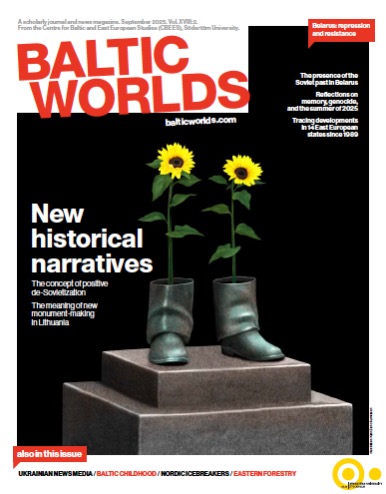In the 1960s, the Soviets took up a rivalry with the US in a hitherto new field, industrial design. ElektroMera was a grandiose effort to produce utilities for everyday use: an effort that nonetheless was never realized in the form of finished products.
By
Margareta Tillberg
July 1, 2010
The development of a system for producing Russian fashion clothing, along with the discussion surrounding this venture into fashion, is described here. The GUM department store established a studio and hired designers. The quality and wealth of ideas was often poor, but demand grew steadily.
Essay by
Sergey Zhuravlev & Jukka Gronow
July 1, 2010
A close reading of Zinoviev and his view of the dissolution of the Soviet Union as a tragedy. Zinoviev helps us to understand how it feels to have your world dismantled and how that experience forms many of the attitudes that lie behind Putin’s policies.
Essay by
Philip Hanson
July 1, 2010
Factors such as widespread ennui and resignation should also be seen as part of the explanation for the dissolution of the Soviet Union. The increasing tristesse, combined with a diminishing fear of reprisals, contributed to the collapse of the system, it is here claimed.
Essay by
Gudrun Persson
July 1, 2010
Andrei Zubov, (ed. and author), Istoriia Rossii, XX vek. 1894–1939, Istoriia Rossii, XX vek. 1939–2007, [The history of Russia:
The 20th century. 1894– 1939; The history of Russia: The 20th century. 1939–2007] Moscow: Astrel 2009, 1,023+829 pages
By
Lennart Samuelson
July 1, 2010
+ Estonian Life Stories, Edited and translated by Tiina Kirss, Compiled by Rutt Hinrikus Budapest: Central European University Press 2009, 539 pages
By
Maija Runcis
March 24, 2010
On the changes in suicide rates in Eastern Europe after the transformations of 1990. Here, a large number of individual studies are summarized, and the results are compared with previous research on transitional societies undergoing rapid change.
Essay by
Ilkka Henrik Mäkinen & Tanya Jukkala
March 24, 2010
In the Soviet Union, maps of reality as it should be were published, and with no information about sensitive data. The manipulation of maps did not, however, disappear with the fall of Communism.
Essay by
Michael Gentile
March 24, 2010
At the exact time that voices in the Swedish public debate increasingly questioned obstacles to women’s participation in professional work on an equal footing with men, the opposite tendency could be observed in Soviet Russian debates. Here an excerpt from a paper presented at the Aleksanteri Institute’s ninth annual conference.
By
Helene Carlbäck
February 24, 2010
During the Cold War each side produced propaganda which highlighted the differences between the two systems and peoples, “the others”.
There were, however, also conceptions of “the other” derived from sporadic but real meetings, meetings which awoke curiosity and a willingness to establish closer relations.
The Aleksanteri Institute’s ninth annual conference, “Cold War: Interactions Reconsidered”, held in Helsinki fall 2009, examined these more low-key contacts and varying interpersonal relations and attitudes.
By
Ninna Mörner
February 24, 2010

 Issue 2025, 2:
Issue 2025, 2:  Baltic Worlds covers; the Baltic Sea Region, Eastern Europe, Russia, CentralAsia, Caucasus and the Balkan area.
Baltic Worlds covers; the Baltic Sea Region, Eastern Europe, Russia, CentralAsia, Caucasus and the Balkan area.